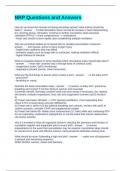NRP Questions and Answers
How do you know the neonate is having secondary apnea? what actions should be
taken? - answer If initial stimulation does not lead to increase in heart rate(warming,
dry, clearing airway, stimulate). Continue to further resucitative steps (assisted
ventilation (PPV))--> chest compressions --> medications
- Heart rate should recover rapidly upon establishing adeqate ventilation
Why are premature babies at increased risk for needing resuscitation measures -
answer - thin tissues- prone to injury oxygen injury
- fragile brain capillaries that may bleed
- immature organs such as lungs with no surfactant, making ventilation difficult
- higher liklihood of infection
What is evaluation based on when deciding which resucitative steps should take place?
- answer - heart rate- (easiest way is through base of umbilical cord)
- oxygenation (color, SpO2 monitoring)
- respirations (breath sounds, chest movement)
What are the first things to assess when a baby is born - answer - is the baby term?
- good tone?
- breathing or crying
Describe the basic reuscitation steps - answer 1) assess- is baby term, good tone,
breathing and crying? if not then bring to warmer and resucitate
2) provide warmth, stimulate, position head and clear airway if necessary, dry, replace
wet towels, evaluate respirations, hear rate and oxygenation (connect spO2 monitor)
3)
a) if heart rate below 100 bpm --> PPV (assited ventilation), if not responding then
check if PPV is being done correctly (MRSOPA)
b) if heart rate is above 100 but labored breathing and cyanotic, monitor with spO2 to
confirm cynaosis, consider CPAP and supplemental oxygen
4) if heart rate below 60- initaite chest compression (3:1 ratio) while also continuing PPV
5) not responding- medications (epinephrine or normal saline flud volume replacement
via venous catheter
why is it imortant to have an organized routne fr checking the presence and function of
reucitation supplies and equipment prior to every birth - answer to ensure
preparedenss in the event that reucusitation may be required. reuscitative steps should
be carried out in quick and efficient manner, being prepared eliminates wasting time.
What should be done if attending a high risk birth - answer - make sure all equipment
is present and functioning properly (
KEEP WARM- warmer, towels and blankets
, CLEAR AIRWAY- suction,
ASSESSMENT- spO2, stethescope
VENTILATE- PPV, oxygen sources, appropriately sized masks, 8F feeding tube and 20
ml syringe
INTUBATE- laryngyscope, blades, light, endotrackeal tubes, laryngeal mask
MEDICATION- 1:10,000 epinephrine, umbilical venous catheter
PREMATURE THERMOREGULATION- plastic wrap, warming pad, transport incubator
routine care of uncomplicated delivery? - answer - dry, provide warmth, clear airway
if necessary, ongoing evaluation.
What do you do if there is meconium present? - answer Assess if baby is vigorous
(strong respiratory efforts, good muscle tone, heart rate over 100)
- VIGOROUS- clear secretions, dry, stimulate, and reposition
- NOT VIGOROUS- suction mouth and trachea to avoid meconium aspiration by
inserting laryngyscope then 12 or 14F suction catheter to clear secretions, then insert
endotracheal tube attached to meconium aspirator
HOW TO SUCTION (settings?) - answer - when suction tubing blocked the negative
pressure should be about 100mmhg
- Mouth suctioned before the nose
- watch out for vagal response from stimulating the posterior pharynx which leads to
bradycardia or apnea. - in this case stop and assess heart rate
PULSE OX - answer - analyzes the color of the blood and compares it to one with a
known saturation of of hemogloblin with oxygen
- should be used to confirm central cyanosis
- help when adjusting the percent oxygen that should be delivered so that oxygen
saturation correlates to expected values after birth (1 min (60-65%) 2 min (65-70%)
3min (70-75%), 4 min (75-80%), 5min (80-85%) 10 min (85-90%)
- best place to put it is on the right arm which recieves blood pre-ductal areriosis blood .
and should be connected to baby before it is connected to instrument
indications for PPV? - answer - not breathing, apneic, or gasping
- HR below 100bpm
- saturation below target value despite free flow O2
PIP
PEEP
CPAP - answer peak inspiratory pressure - the pressure delivered with each breath.
(20-40cm H2O)
Positive end expiratory pressure- pressure in the lungs remaining after exhalation or
between breaths, (during relaxation of the lungs)
Continuous positive airway pressure- same as peep given when baby breathing
spontaneously




